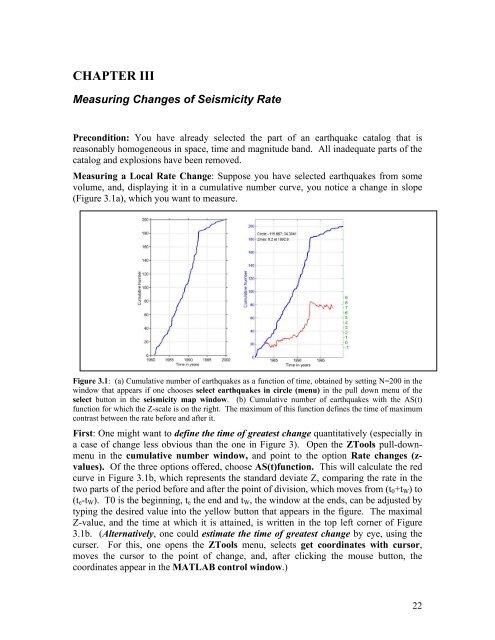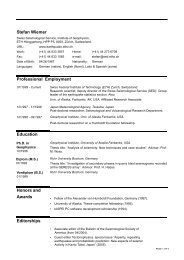zmap a tool for analyses of seismicity patterns typical applications ...
zmap a tool for analyses of seismicity patterns typical applications ...
zmap a tool for analyses of seismicity patterns typical applications ...
You also want an ePaper? Increase the reach of your titles
YUMPU automatically turns print PDFs into web optimized ePapers that Google loves.
CHAPTER III<br />
Measuring Changes <strong>of</strong> Seismicity Rate<br />
Precondition: You have already selected the part <strong>of</strong> an earthquake catalog that is<br />
reasonably homogeneous in space, time and magnitude band. All inadequate parts <strong>of</strong> the<br />
catalog and explosions have been removed.<br />
Measuring a Local Rate Change: Suppose you have selected earthquakes from some<br />
volume, and, displaying it in a cumulative number curve, you notice a change in slope<br />
(Figure 3.1a), which you want to measure.<br />
Figure 3.1: (a) Cumulative number <strong>of</strong> earthquakes as a function <strong>of</strong> time, obtained by setting N=200 in the<br />
window that appears if one chooses select earthquakes in circle (menu) in the pull down menu <strong>of</strong> the<br />
select button in the <strong>seismicity</strong> map window. (b) Cumulative number <strong>of</strong> earthquakes with the AS(t)<br />
function <strong>for</strong> which the Z-scale is on the right. The maximum <strong>of</strong> this function defines the time <strong>of</strong> maximum<br />
contrast between the rate be<strong>for</strong>e and after it.<br />
First: One might want to define the time <strong>of</strong> greatest change quantitatively (especially in<br />
a case <strong>of</strong> change less obvious than the one in Figure 3). Open the ZTools pull-downmenu<br />
in the cumulative number window, and point to the option Rate changes (zvalues).<br />
Of the three options <strong>of</strong>fered, choose AS(t)function. This will calculate the red<br />
curve in Figure 3.1b, which represents the standard deviate Z, comparing the rate in the<br />
two parts <strong>of</strong> the period be<strong>for</strong>e and after the point <strong>of</strong> division, which moves from (t0+tW) to<br />
(te-tW). T0 is the beginning, te the end and tW, the window at the ends, can be adjusted by<br />
typing the desired value into the yellow button that appears in the figure. The maximal<br />
Z-value, and the time at which it is attained, is written in the top left corner <strong>of</strong> Figure<br />
3.1b. (Alternatively, one could estimate the time <strong>of</strong> greatest change by eye, using the<br />
curser. For this, one opens the ZTools menu, selects get coordinates with cursor,<br />
moves the cursor to the point <strong>of</strong> change, and, after clicking the mouse button, the<br />
coordinates appear in the MATLAB control window.)<br />
22



